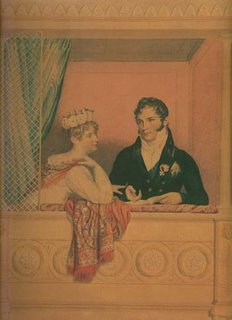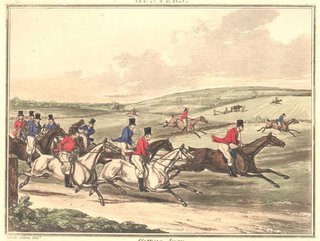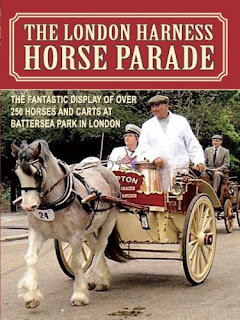.
Originally this was going to be a post about weather during the Regency weather, something I was determined to blog about before the official arrival of spring, although here (near Washington DC) it’s warm and sunny and daffodils are blooming. I did however do some digressions, some of which turned out to be more interesting.
England in Jane Austen’s time was in the grip of a minor Ice Age that had begun in medieval times and lasted up until the mid-nineteenth century–hence the snowy cold winters of A Christmas Carol and the Pickwick Papers. It was cold enough for the river Thames to freeze over completely, which it did for several months in some particularly cold years. In the sixteenth century Henry VIII traveled from London to Greenwich along the Thames by sleigh. What better opportunity for the enterprising merchants of London to set up shop on the river, thus creating Frost Fairs, the most famous of which (featured in Orlando by Virginia Woolf) was held in 1608 .
.
 The Frost Fair of 1814 was the last of its kind, and featured an elephant being led across the ice near Blackfriars Bridge (according to one source I found), donkey rides, and the roasting of a whole sheep on the ice. People had to pay to see the sheep roasted and then pay for a portion of “Lapland Sheep.” Nine printing presses churned out souvenir items. This fair only lasted four days until a thaw set in.
The Frost Fair of 1814 was the last of its kind, and featured an elephant being led across the ice near Blackfriars Bridge (according to one source I found), donkey rides, and the roasting of a whole sheep on the ice. People had to pay to see the sheep roasted and then pay for a portion of “Lapland Sheep.” Nine printing presses churned out souvenir items. This fair only lasted four days until a thaw set in.
The weather, of course, is always a safe conversation topic–particularly if the man of your dreams has appeared unexpectedly:
But it was then too late, and with a countenance meaning to be open, she sat down again and talked of the weather.
That’s Elinor, from Sense and Sensibility, whose keen sense of the appropriate phrase gives her a certain affinity with Jim’s aunt in A Child’s Christmas in Wales by Dylan Thomas:

And when the firemen turned off the hose and were standing in the wet, smoky room, Jim’s Aunt, Miss Prothero, came downstairs and peered in at them. Jim and I waited, very quietly, to hear what she would say to them. She said the right thing, always. She looked at the three tall firemen in their shining helmets, standing among the smoke and cinders and dissolving snowballs, and she said, “Would you like anything to read?”
I have to mention a couple of fascinating sites I came across while trying to find a good Jane Austen quote about the weather (the one I was originally looking for, about a stupendously cold snap in London, is in Emma, I think). There is for your edification, a site with a search function for Sense and Sensibility, and other books too, Tilneys and Trap-doors, and that site also includes the Henry Tilney Fan Site–yes, the man who knows how to wash muslin. Who would’ve thought it.
Any polite comments on the weather, literary examples thereof, or really excellent time wasters online?





